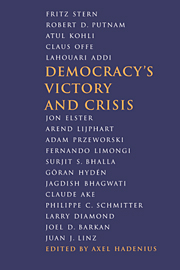Book contents
- Frontmatter
- Contents
- List of contributors
- Acknowledgments
- 1 Victory and crisis: introduction
- Part 1 Historical perspectives
- Part 2 Social and cultural aspects
- 3 Democracy in America at century's end
- 4 On sources of social and political conflicts in follower democracies
- 5 Micro-aspects of democratic theory: what makes for the deliberative competence of citizens
- 6 Political Islam and democracy: the case of Algeria
- Part 3 Constitutional questions
- Part 4 Democracy and development
- Part 5 Democracy and globalization
- Part 6 Promoting democracy
- Index
3 - Democracy in America at century's end
Published online by Cambridge University Press: 13 October 2009
- Frontmatter
- Contents
- List of contributors
- Acknowledgments
- 1 Victory and crisis: introduction
- Part 1 Historical perspectives
- Part 2 Social and cultural aspects
- 3 Democracy in America at century's end
- 4 On sources of social and political conflicts in follower democracies
- 5 Micro-aspects of democratic theory: what makes for the deliberative competence of citizens
- 6 Political Islam and democracy: the case of Algeria
- Part 3 Constitutional questions
- Part 4 Democracy and development
- Part 5 Democracy and globalization
- Part 6 Promoting democracy
- Index
Summary
Abstract
Alexis de Tocqueville attributed the success of democracy in America to an unusual national propensity for civic engagement. Recent empirical research in a wide range of contexts has confirmed that the norms and networks of civic engagement (now rebaptized “social capital”) can improve education, diminish poverty, inhibit crime, boost economic performance, foster better government, and even reduce mortality rates. Conversely, deficiencies in social capital contribute to a wide range of social, economic, and political ills.
Unfortunately, new evidence also suggests that civic engagement of many sorts has unexpectedly plummeted in the United States over the last generation. The initial installment of a larger inquiry into social capital formation in America, the present paper documents these trends and explores their origins and their implications for contemporary democracy.
Beyond the familiar falloff in electoral turnout, many other forms of political participation have also declined significantly over the last two decades, at the same time that political alienation and distrust in public institutions has climbed. Moreover, participation has fallen (often sharply) in many types of civic associations, from religious groups to labor unions, from women's clubs to fraternal clubs, and from neighborhood gatherings to bowling leagues. Virtually all segments of society have been afflicted by this lessening in social connectedness, and this trend, in turn, is strongly correlated with declining social trust. In sum, many forms of American social capital have badly eroded in the last quarter century.
What can explain this turn of events? Several explanations are possible, including the movement of women into the paid labor force, rising geographic mobility, and technological change that is ‘privatizing’ Americans' leisure-time.
- Type
- Chapter
- Information
- Democracy's Victory and Crisis , pp. 27 - 70Publisher: Cambridge University PressPrint publication year: 1997
- 15
- Cited by



